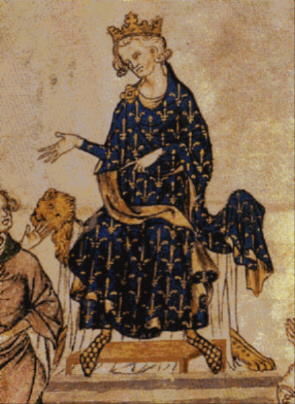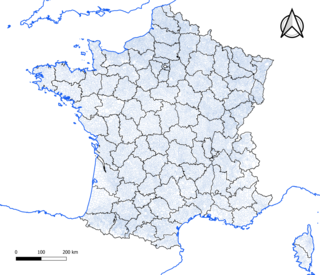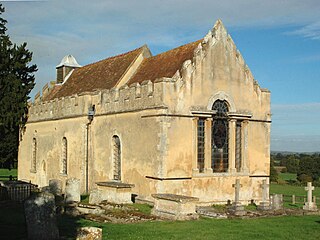Related Research Articles
A poll tax, also known as head tax or capitation, is a tax levied as a fixed sum on every liable individual, without reference to income or resources. Poll is an archaic term for "head" or "top of the head". The sense of "counting heads" is found in phrases like polling place and opinion poll.

Philip VI, called the Fortunate or the Catholic and of Valois, was the first king of France from the House of Valois, reigning from 1328 until his death in 1350. Philip's reign was dominated by the consequences of a succession dispute. When King Charles IV of France died in 1328, the nearest male relative was his nephew King Edward III of England, but the French nobility preferred Charles's paternal cousin Philip.

Haute-Vienne is a département in the Nouvelle-Aquitaine region in southwest-central France. Named after the Vienne River, it is one of the twelve départements that together constitute Nouvelle-Aquitaine. The prefecture and largest city in the department is Limoges, the other towns in the department each having fewer than twenty thousand inhabitants. Haute-Vienne had a population of 372,359 in 2019.

In France under the Ancien Régime, the Estates General or States-General was a legislative and consultative assembly of the different classes of French subjects. It had a separate assembly for each of the three estates, which were called and dismissed by the king. It had no true power in its own right as, unlike the English Parliament, it was not required to approve royal taxation or legislation. It served as an advisory body to the king, primarily by presenting petitions from the various estates and consulting on fiscal policy.
A property tax is an ad valorem tax on the value of a property.

The commune is a level of administrative division in the French Republic. French communes are analogous to civil townships and incorporated municipalities in the United States and Canada, Gemeinden in Germany, comuni in Italy, or municipios in Spain. The UK equivalent are civil parishes. Communes are based on historical geographic communities or villages and are vested with significant powers to manage the populations and land of the geographic area covered. The communes are the fourth-level administrative divisions of France.

The Flemish peasant revolt of 1323–1328, sometimes referred to as the Flemish Coast uprising in historical writing, was a popular revolt in late medieval Europe. Beginning as a series of scattered rural riots in late 1323, peasant insurrection escalated into a full-scale rebellion that dominated public affairs in Flanders for nearly five years until 1328. The uprising in Flanders was caused by excessive taxations levied by the Count of Flanders Louis I and by his pro-French policies. The insurrection had urban leaders and rural factions, which took over most of Flanders by 1325.

Vitré is a commune in the Ille-et-Vilaine department in Brittany in northwestern France.
The Ottoman Armenian population varied throughout history. The number of Armenians within the empire between 1914 and 1915 is a controversial topic. Most estimates by Western scholars range from 1.5 to 2.4 million. According to Britannica prior to 1915 and Samuel Cox, American Embassy in Istanbul from 1880-1886, it was 1.75 million and 2.4 million, respectively.

André Pieyre de Mandiargues was a French writer born in Paris. He became an associate of the Surrealists and married the Italian painter Bona Tibertelli de Pisis. He was a particularly close friend of the painter Leonor Fini.

The Kingdom of France is the historiographical name or umbrella term given to various political entities of France in the medieval and early modern period. It was one of the most powerful states in Europe since the High Middle Ages. It was also an early colonial power, with colonies in Asia and Africa, and the largest being New France in North America.

The Bretons are a Celtic ethnic group native to Brittany, north-western France. They trace their heritage to groups of Brittonic speakers who emigrated from southwestern Great Britain, particularly Cornwall and Devon, mostly during the Anglo-Saxon settlement of Britain. They migrated in waves from the 3rd to 9th century into Armorica, which was subsequently named Brittany after them.

A hearth tax was a property tax in certain countries during the medieval and early modern period, levied on each hearth, thus by proxy on wealth. It was calculated based on the number of hearths, or fireplaces, within a municipal area and is considered among the first types of progressive tax.

Wheatfield is a civil parish and deserted medieval village about 4 miles (6.4 km) south of Thame in Oxfordshire. Wheatfield's toponym is derived from the Old English for "white field", referring to the ripe crops that the Anglo-Saxons grew on its fertile land. Few of Wheatfield's buildings remain today except the Church of England parish church of Saint Andrew, the former rectory and the former outbuildings of the no-longer-standing manor house.

Merzweiler is an Ortsgemeinde – a municipality belonging to a Verbandsgemeinde, a kind of collective municipality – in the Kusel district in Rhineland-Palatinate, Germany. It belongs to the Verbandsgemeinde Lauterecken-Wolfstein.

Opoul-Périllos is a commune in the Pyrénées-Orientales department in southern France.

The Hundred Years' War was a series of armed conflicts fought between the kingdoms of England and France during the Late Middle Ages. It originated from English claims to the French throne. The war grew into a broader power struggle involving factions from across Western Europe, fueled by emerging nationalism on both sides. The periodization of the war takes place over 116 years, wherein the war was interrupted by several years of truces.
The Harelle was a revolt that occurred in the French city of Rouen in 1382 and followed by the Maillotins uprising a few days later in Paris, as well as numerous other revolts across France in the subsequent week. France was in the midst of the Hundred Years' War, and had seen decades of warfare, widespread destruction, high taxation, and economic decline, made worse by bouts of plague. In Rouen, the second largest city in the kingdom, the effects of the war were particularly felt.
Andrew Wareham is a British historian who has written numerous books and articles on Anglo-Saxon history, Anglo-Norman history and the hearth tax. He is employed as a reader in the department of humanities at Roehampton University, London.

Las Illas is a former commune in Pyrénées-Orientales (France), now part of Maureillas-las-Illas.
References
- ↑ "sans feu ni lieu"
- ↑ The Reformation of 1426
- ↑ Jacques Dupâquier, History of the French Population, Paris, PUF, 4 volumes, 1988, p. 38 (in French)
- ↑ The Census of Population and the "counting of the fires" (in French)
- ↑ Serge Dontenwill, Aspects of everyday life and social organisation of the peasant communities of the Central South-East of France in the time of Louis XIV (1638-1715), Dix-septième siècle, 2007/1 No. 234, p. 106